Gerrit Cramer Culpeper-Style Microscope
Though this ornamental mid-1700s microscope is unsigned, its fabrication has been attributed to Gerrit Cramer, an instrument maker from Gronigen, Netherlands. The model of the attractive Culpeper-style microscope presented below was based on a color photograph of the original in Maria Rooseboom's book entitled Microscopium.

Illustrations of an insect, a bunch of grapes, and a man of letters in two different poses decorate the barrel of the ebony and brass optical instrument. Also, ornate scrollwork and engravings provide the illusion of climbing vines and tendrils along the lower portion of the microscope's brass tripod. As an additional decorative touch, the black ebony base is highlighted with inlaid pewter, an embellishment that is similarly featured on the barrel of the compound microscope.
Functional despite its decorative appearance, an adjustable, brass-framed concave mirror is mounted onto the instrument's base with a gimbal in order to gather ambient light. Below a circular central aperture, a light-focusing device is suspended from the lower surface of the stage. The lower end of the microscope's barrel holds a single objective and an ocular fixed in a brass eyepiece tops the instrument. Coarse focus may be accomplished by turning the top portion of the microscope body, which screws into the lower portion on brass threads. A Lieberkühn reflector supported by a jointed arm, which attaches to the stage, dates the construction of the microscope to after 1738, the year the device was invented by Johannes Nathaniel Lieberkühn.
BACK TO EIGHTEENTH CENTURY MICROSCOPES
